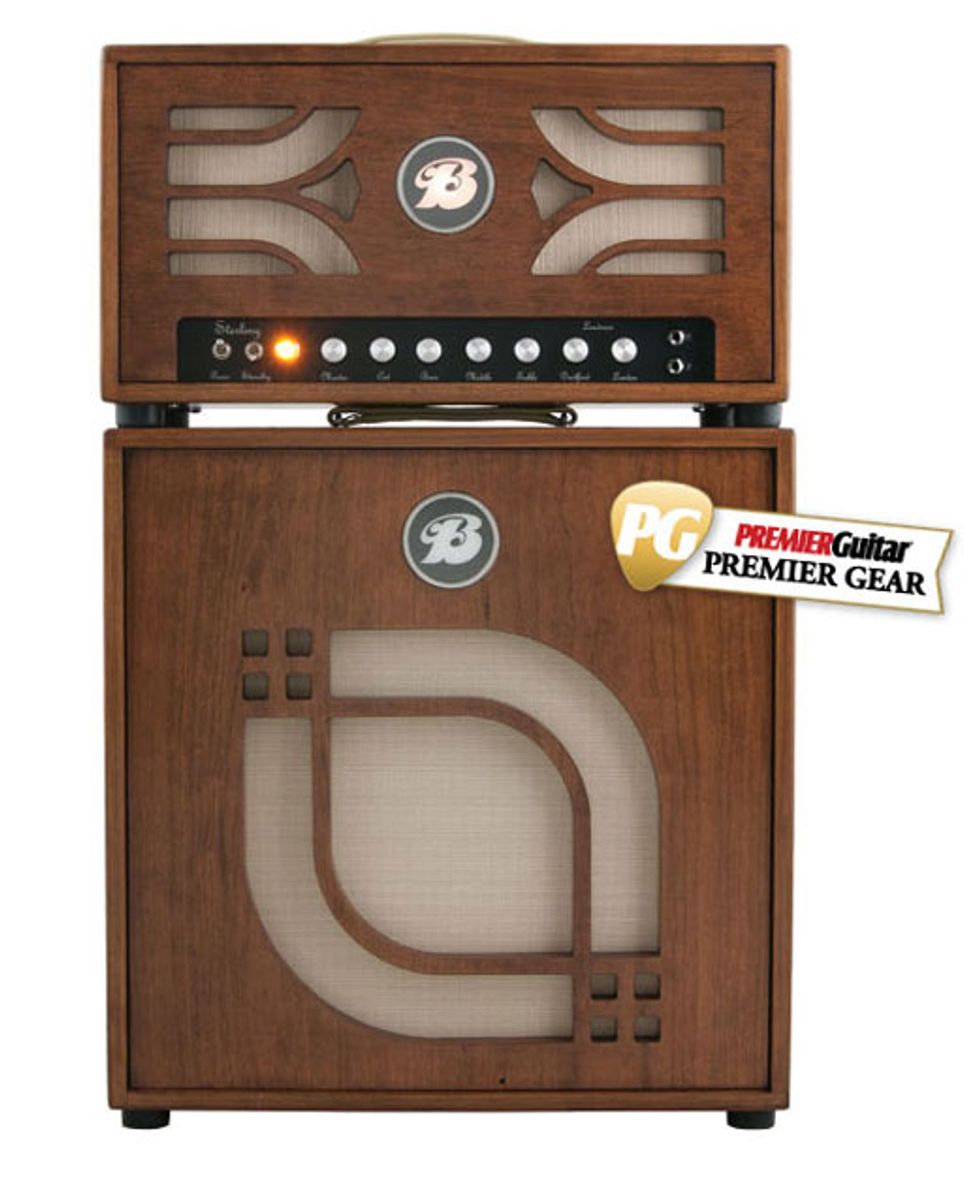The only thing better than the sound of a classic tube amp moving air is the sound of two classic tube amps working together. Combine them in a single head and you’re really onto something. This is the neat trick behind the Bradford Sterling, a British-inspired, 18-watt, EL84-powered, two-headed monster from Nashville boutique builder Bradford Shoemaker.
Two Pounds Sterling
The Sterling’s independent dual channels are called Dartford and London in honor of their respective Vox and Marshall inspirations. Both channels produce crisp, driving, and heady tones. Using Shoemaker’s included A/B/Y switcher, you can drive each channel separately, or summon both simultaneously, blending voices associated with an AC-30 and a plexi into a single sonorous growl.
Shoemaker likens this combination effect to jumped channels on a plexi head—a trick that propelled some of the beefiest tones of the ’60s and ’70s, including those of Jimi Hendrix and Steve Marriott. Here, however, the channels work together to create one unique voice.
The Sterling is a cool-looking amp. Shoemaker hand-builds his dovetailed cabinets and amp enclosures from Appalachian Cherry wood, with a nod to your great-granny’s floor radio via ornate, deco-influenced front panels. When the head is powered up, a big B lights up on the front—a touch that might be over-the-top if the whole package wasn’t so classy and well crafted.
Under the Cherry Hood
The Sterling’s interior workmanship is also exquisite. Shoemaker neatly hand-wires the entire circuit, which gives the innards a sleek industrial charm. Like its 36-watt big sister, the Nobility, the Sterling is built around EL84 tubes, 12AX7 preamp tubes, and an EZ81 rectifier (though Shoemaker will pop in two 6L6s instead of the EL84s if customers desire). There’s a nice, quiet effect loop and switchable impedance. The master volume is the post-phase inverter type—another plexi nod. And thanks in part to cathode bias, the Sterling has natural compression that keeps tones tight and spanky, enabling effects to work at their extremes without making mud. The custom-wound transformer comes from Chicago’s Magnetic Components, and the speaker is a 30-watt Weber Legacy Series with a fat ceramic magnet. It barks like a rottweiler.
The Road Test
The Dartford preamp channel sings in crisp, bright tones with superb articulation that graduates to rich overdrive as it moves toward 10. The London channel is based on a classic JTM preamp circuit, with tighter lows and a clearer midrange voice. And while the actual drive from Dartford to London takes about an hour, the trip here requires only a foot tap.
Ratings
Pros:
Excellent classic British sounds. Independent channels and channel blending. Highly responsive. Superb craftsmanship. Cool design.
Cons:
No reverb.
Tones:
Playability/Ease of Use:
Build/Design:
Value:
Street:
$1,895 (head), 1x12 cabinet $600 with Ted Weber Legacy Series or Silver Bell speaker
Bradford Amps Sterling
bradfordamps.net
I started testing with a ’72 Stratocaster rigged with a trio of Seymour Duncan Alnico II APS pickups. The treble-cut control helped soften the barbed snap of the Strat’s bridge pickup. The control has much range—at maximum, it sounded like I was playing a jazz hollowbody with flatwounds. In the middle you’ll find a world of bristling, clear, and nasty classic rock tones of exceptional immediacy, thanks to the Sterling’s super-fast response. Compared to the Dartford channel, the London responds sweetly to single-coils with warm, burnished lows and mids.
The real fun starts when you blend the channels. If I’d been walked blindfolded into the room, I’d have sworn a vintage Marshall and Vox were battling it out. Because the preamp channels are independent, you can emphasize one over the other. Pushing the Dartford a click-and-a-half above the London, for example, produces a fantastic fusion of the fat lows and midrange rush of a plexi with the sparkling highs of a Vox. The combination is simultaneously evil and gorgeous.
Humbuckers tease different flavors from both channels. Each pickup setting absolutely kicked, with both low-end push and high-end clarity. I was delighted by how effectively the channels paired to create glorious harmonic architecture. A little extra Dartford voice brought out the best in the Gibson—and the amp.
The Verdict
By boutique standards, the price for a matched Sterling head and 1x12 open-back cabinet is reasonable, especially since you get two classic tone-generators and one of the coolest looking amps on the scene. It covers all the crucial bases for players who worship at the temple of British rock and blues, but it’s the extras that make it truly special. The low and midrange tone-sculpting power are invaluable when switching between guitars, and the straightforward channel switching/blending might replace several pedals on your board. The Sterling's combination of aesthetics, tones, and flexibility is nothing short of spectacular.















![Rig Rundown: Russian Circles’ Mike Sullivan [2025]](https://www.premierguitar.com/media-library/youtube.jpg?id=62303631&width=1245&height=700&quality=70&coordinates=0%2C0%2C0%2C0)




